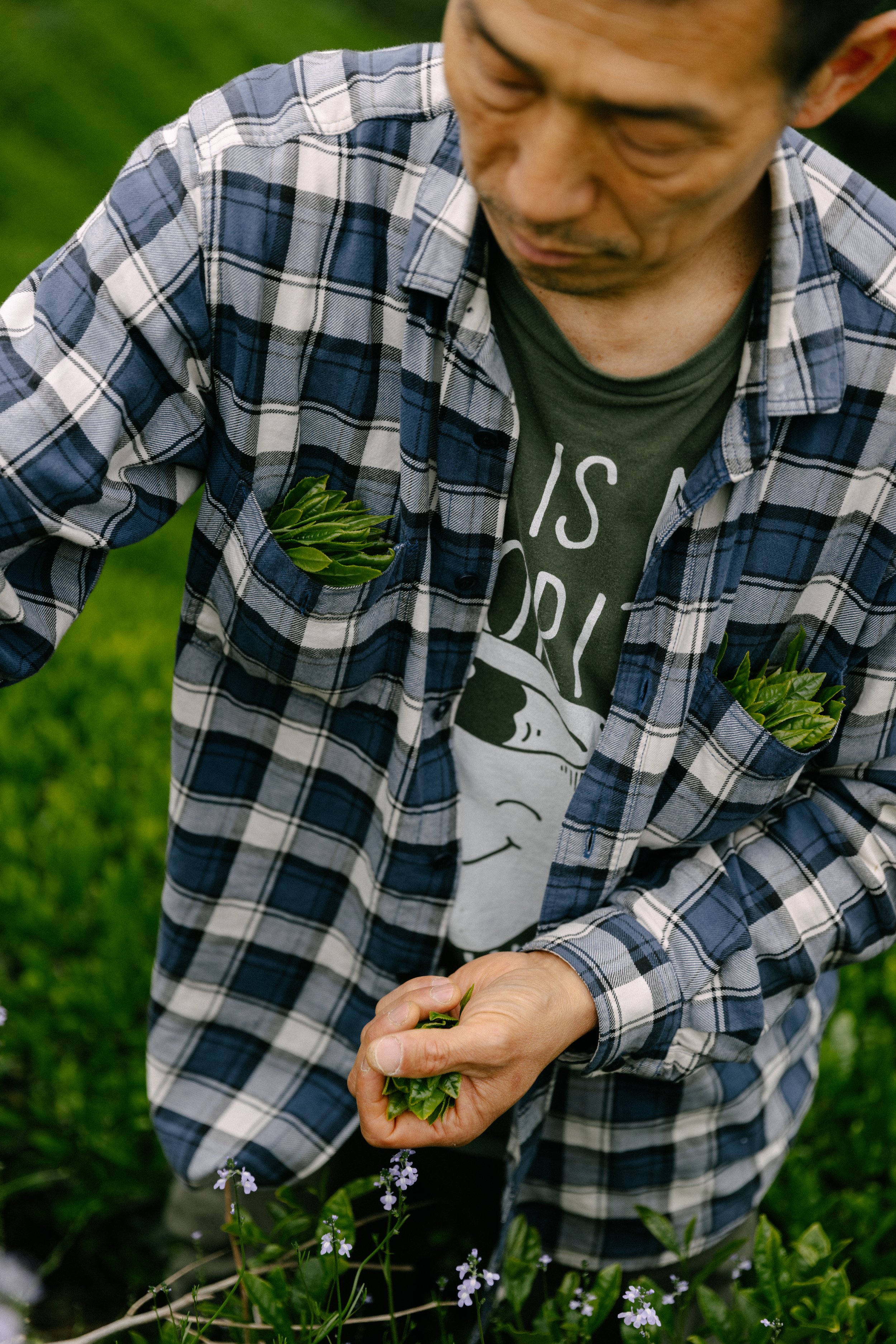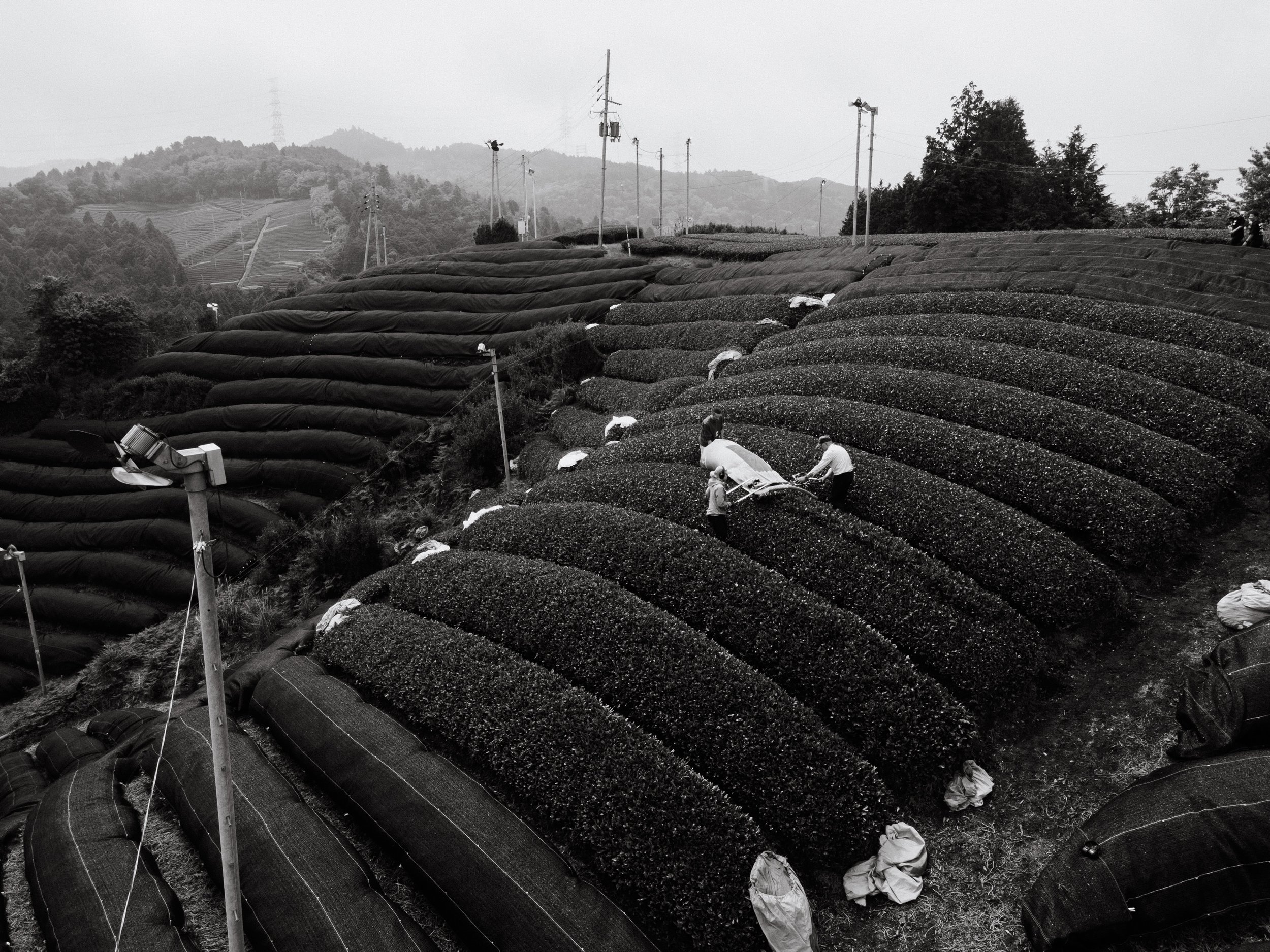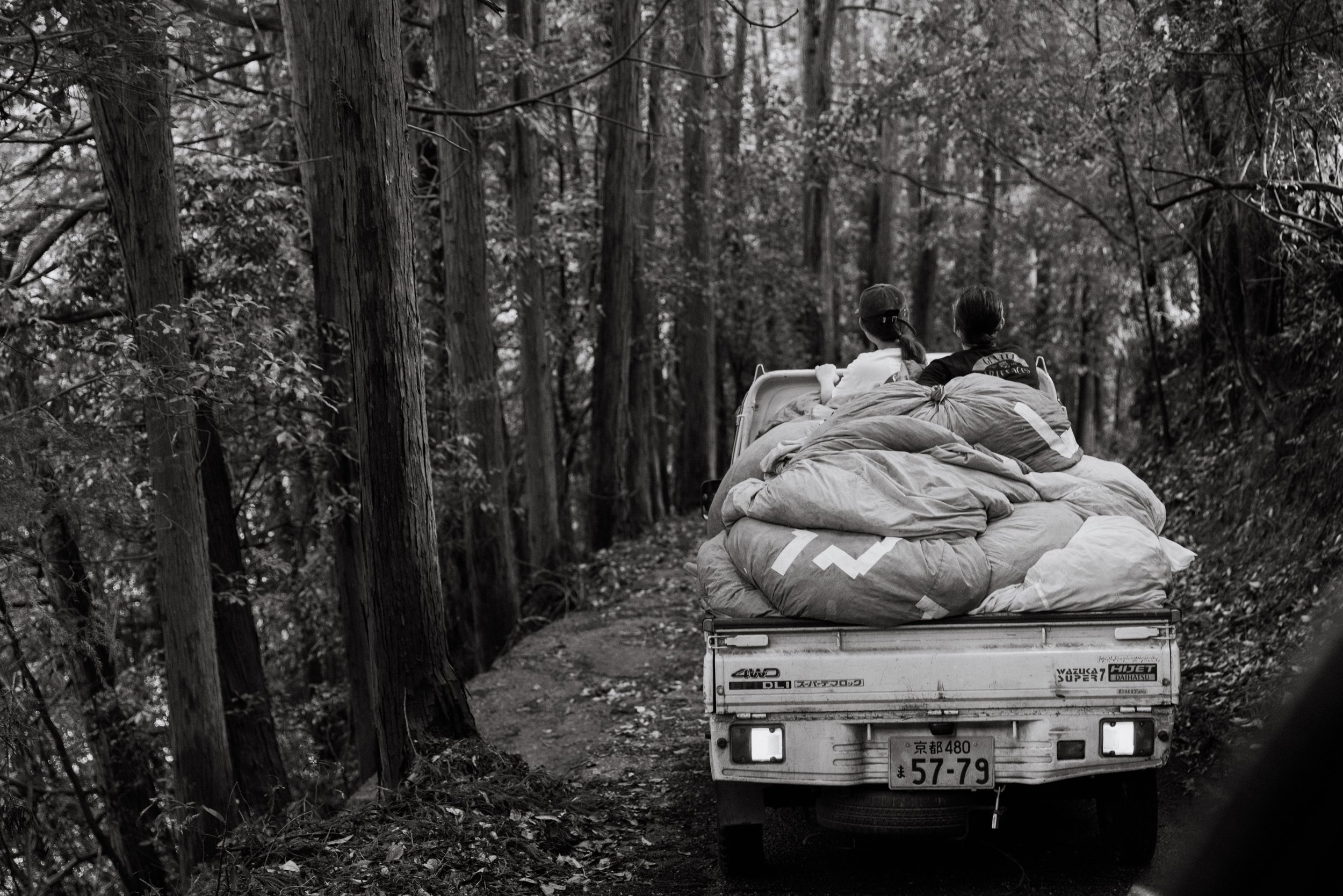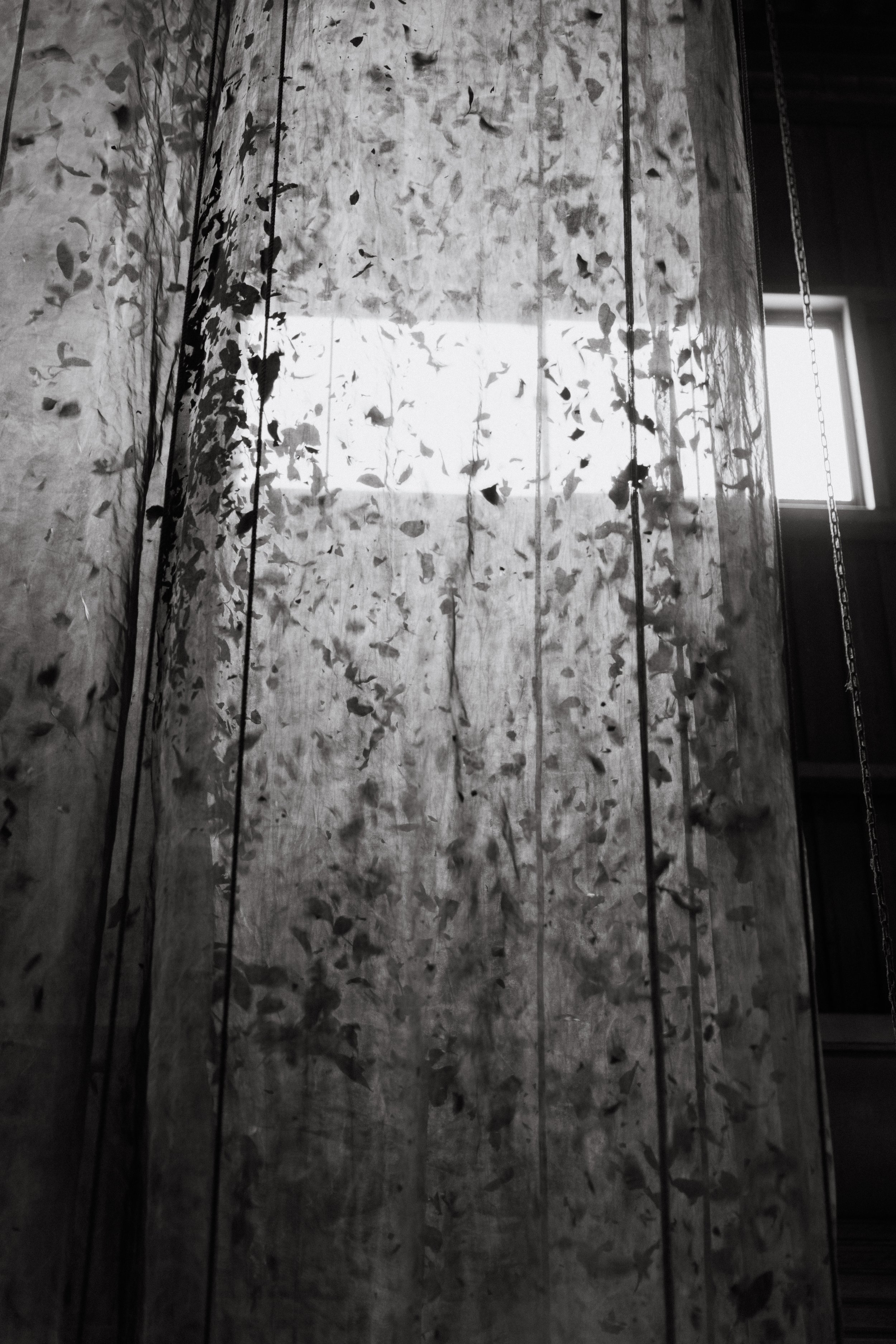Ethnographic returns — Spring harvest in Wazuka, Uji
Returning ‘home’ for harvest
May 12th, 2025. It is 6:45am in Minamiyamashiro Village, a hamlet on the Kizu river, which flows southeasterly through Kyoto prefecture’s ‘Uji tea’ producing territories. Sabrina and I are joined by Takeshi and Fumiya, the Street Dreams Magazine, Tokyo photographers who accompanied us for the fieldwork we’d conducted at Obubu Tea Farms during the dormant winter season several months prior. Now it is the height of the spring’s first harvest for the tea farmers across this region, and we have returned.
Loading up the rental car with photographic equipment and samples for a capsule collection inspired by an ethnographic encounter between the Obubu’s farmers and the fashion designer Mark Ong (a.k.a. Mr. Sabotage), we set off along meandering mountain roads (Prefectural Routes 163 and 5) towards Obubu Tea Farms, 22 kilometers away in neighboring Wazuka Town. When we were last here, in January, a bright sun radiating in cloudless skies had warmed us through the winter chill. But now it is both damp and brisk, and the daybreak greets us with a vaporous medley of morning mist, fog, and dew—the horizon an atmospheric melding of green landscapes and mottled grey skies.
Above: Headed West along the Kizu river from Minamiyamashiro Village towards Wazuka.
Below: Descending through the wooded grove that emerges at Obubu Tea Farm’s tea processing factory and café, photographer Takeshi Hayakawa remarks that we—he and Fumiya of Street Dreams Tokyo and Sabrina and Gabriel of Gentle Artefacts—have “come back home.”
From Obubu Tea Farms to Obubu Farm’s tea fields
Matsu-san, who among other things is one of Obubu Tea Farm’s founders, meets us when we arrive at Obubu’s processing facility and café—an iconic building featuring a stylized mural of Akky-san, who is another of Obubu’s founders and the farmer responsible for producing it’s matchas and teas. Although it is still well-before 8am, Akky is already up in the fields, and we are going to meet him—but first we must exchange our sneakers and loafers for rubber galoshes and our Prius for a vehicle with 4-wheel drive.




Booted up in rubbers for the rain and terrain, we pack into the off-road-ready minivan, with Matsu at the wheel. The tea field to which we are headed to meet up with Akky for the morning harvest is a twenty-some-odd drive from Obubu Farm’s offices in Wazuka town. Farmlands in Japan, generally, are patchworks of small, mis-sized, often oddly shaped plots. There are many reasons for this, including (but by no means determined by) the fact that as little of 14% of Japan’s island archipelago landmass is arable (in late modern Japan, for example, the only staple crop that Japanese don’t need to subsidize with imports is rice). Just as in postwar Japan’s cities—where urban planning has proceeded absent of strict zoning or uniform construction codes, and one therefore finds homes and shops squeezed into highly irregular spaces—contemporary Japan’s agrarian lands are demarcated and parceled out in a complex hodge-podge of smallholdings. This is no longer the case where large-scale highly industrialized agriculture reigns (ever increasing). But in Wazuka, Uji, where independent, small-scale, and more traditional or artisanal farming continues to be practiced, land apportioned into micro and mini lots with nearly overlapping ownership remains the norm.
Given the mountainous terrain of the region, plus its land’s long lineage of being cultivated for tea production (over 800 years), Wazuka’s tea plots have in particular been adapted in this sense, sized as they are for whatever arable space a steep, elevation-changing hillside can provide an enterprising farmer. And Obubu Farms’s is especially exemplary as a case of this point: as a first generation farm established in a historic tea farming community built around the industry of 250 legacy family producers, Obubu has steadily if modestly expanded year by year by acquiring the rights to rent and work tea fields that would otherwise fall fallow due to a family’s retirement from the profession. An acquisition strategy suited to these times, Obubu today comprises 4.2 hectares of tea fields that are distributed across 21 discrete plots. To put these figures in perspective, the average size of one of Obubu’s tea fields is 0.2 hectares—approximately 25,500 square feet or just under ½ of an acre (a very well appointed, oversized lot for a suburban home, for example). A twenty-minute drive from the farm out (and up) to one of its fields is totally typical.
Across Wazuka town, we bank onto a mountain road and begin to climb. Another turn-off takes us to an unpaved, single-lane muddy dirt road meandering through cedar, pine, and bamboo forest (hence the 4-wheel drive), which we slowly ascend. Emerging up and out into a clearing, we are met by the dramatic vertical sweep of tea rows, which ring around a bowl-shaped depression at the mountain’s peak. We see Akky fourteen or fifteen rows up, readying the area.
Local agricultural practices: shading techniques and the evolution of shaded tea types in Japan
As is visible in the photo of Akky just above, each row of tea plants in the field we arrive to is covered in semi-porous black netting, which means that the buds we’ll be harvesting have been allocated for the production of shaded tea types like kabuse sencha, gyokuro, or matcha. Kabuse means ‘shaded,’ a cultivation technique developed and almost exclusively practiced in Japan (tea producers in China independently experimented with shading teas and a select few have in modern times re-appropriated the method from Japanese). Shading the plants in the period immediately preceding its harvest reduces the sunlight they receive by between 70% and 95%, which drastically delimits the degree of photosynthesis that the plants can conduct. Technically, what shading effectuates is an elevation of L-theanine in the leaves coupled with a suppression of catechin formation; sensuously, elevated L-theanine draws out and enhances the umami profile of the tea that the plants become while lowering the catechin contents limits their tannic astringency, leading to a more balanced end product. The leaves become sweeter (higher sugar content build up due to reduced photosynthesis) and a deeper shade of green (chlorophyll accumulation).
Put this way, shading may sound very scientific, like contemporary knowledge of life at the intersection of biochemistry and botany. But shading is a technical innovation in tea cultivation that emerged from experiential, embodied, and practical knowledge—by the late 16th century, artificial or intentional shading had appeared and was spreading throughout Uji and beyond, eventually transforming the production and profile of matcha into something close to what we know it as today; and it was the bricolage of an Uji tea farmer nearly 300 years ago, in 1730, which resulted in the combination of shaded growth with a steaming/rolling processing method (the latter augmented from a technique indigenous to China) to create the first sencha. (For a synopsis, see the genealogical passages in our collaborations profile on Obubu Tea Farms.) To this day, every artisanal farm and farmer varies in their sensibilities w/r/t shading and approaches their shading choices and practices variably as well, season to season. When you drive or travel by train through the tea producing countrysides of Japan in the spring and early summer—especially in Kyoto’s Uji region, where shading and the types of tea that result from it were invented, and where many of the finest sencha continues to be produced today—you see rows of tea fields covered, sometimes in white and sometimes in black materials. Indeed, one sees shading where the cloth directly covers the tea bushes, like a baby’s swaddling (known as jikakabuse); one sees cloth pitched above the plants, like a tarp when camping (known as kanreisha); and one even sees, albeit rarely, tarp-like coverings, but where the synthetic cloth is swapped for screens composed of woven reeds and straw mats—an originary (or at least old-timey) method known as honzu.
“The choice of white coverings means that the material refracts all the light, whereas the black material absorbs the whole spectrum of light instead,” Matsu-san tells us when I ask him about it. “At Obubu, we only use the black now. It’s a judgement based on experience; as with everything, there are trade-offs.”
— Matsu san, co-founder of Obubu Tea Farms
The determinations hardly stop there. Depending on the terroir, the climate, the particulars of the winter and early spring seasons, the cultivar in question, the age of the plants, and the personal style and orientation of the farmer, shading typically ranges from 10 to 35 days: roughly, one to two weeks for kabuse sencha, three to four weeks for gyokuro, and anywhere from 20 to as many as 60 days for tencha that is to be ground into matcha.
When we greet him, Akky informs us that the plot we are harvesting is Yabukita, that it has been shaded for 24 days (employing the direct, jikakabuse covering system), and that he has cultivated the plants in this plot to become tencha—even though Akky typically reserves his finest Yabukita crops for sencha and gyokuro (notably, while the majority of tea produced in Japan today is sencha, less than 5% of it is shaded sencha). And although Yabukita is the most prevalent of the cultivars being produced in Japan today—upwards of 70% of tea production in Japan in any given year these days is reportedly Yabukita—for Akky and Obubu Farms, it isn’t a go-to cultivar for making tencha and matcha. “I think—for me—Okumidori is very best for matcha,” Akky said to us during our field trip to Obubu Farms last January. And Akky puts his matcha where his mouth is, as it were, in that Akky has focused Obubu’s matcha cultivation on Okumidori, which was the product of a cross between Yabukita and a Zairi strain from Shizuoka (Zairi, Matsu explained to us also in January, refers to tea plants cultivated from seeds rather than the controlled, clonal propagation methods of cutting/grafting, which is the standard approach tea farmers take to reproduction. In Japanese, zairi means ‘native,’ which is a perfect term because it indicates what experimental biologists refer to as a ‘wild type,’ meaning genetically similar but not identical to a standardized or model organism. Both Akky and Matsu have an untimely affinity for zairi, and they have integrated zairai plants into their production program at a time when they falling by the wayside for mainstream farmers. In addition to their genetic heterogeneity, zairai plants tend to be older—past the peak producing years of 10-40 years—and they not only produce less abundantly than their cultivar-specific cousins, but their leaves don’t mature at a uniform rate, which presents a difficulty for timing harvests.) Despite Yabukita’s ubiquity to Japan tea today, Matsu describes it as “a very old school cultivar.” In line then with the ethos that informs Obubu Farm’s approach to tea cultivation today—actively extending by attending to traditions while nurturing novelty through innovation—Akky’s conscription of Yabuika plants for Obubu’s matcha menu this year means rising to the modernist challenge to “make it new.”
Participant-observations: a morning harvesting tea for tencha
When we arrive to the tea field, Akky is already sweating as he moves up and down covered rows of tea plants, taking measure. He yips a welcome “ahh” when our caravan arrives, and we begin unloading the gear we’ve hauled up. In addition to Matsu, Sabrina and me, and Takeshi and Fumiya, we are joined by two of Obubu’s seasonal interns, who are staffed on “Akky support” for this morning’s shift. (During Spring harvest, Akky is appointed at least two support staff, who are drawn from the ranks of Obubu’s interns and assistant managers, over two daily shifts, which run roughly from 8am to 3pm and 3pm to 10 or 11pm.) During this crucial season, Akky begins each day at dawn’s first light, harvesting in the fields, and then works well into the night (or next morning) processing the day’s yields in Obubu’s factory. In addition to the in some ways punishing intensity of the undertaking, the spring harvest of craft-scale tea crops can’t be chipped away at programmatically, at least not day to day. With so many variables impacting ,lead farmers like Akky can plan for but cannot precisely predict which plots, fields, or rows will be optimally ready for harvesting too much advance. Each new day requires a fresh assessment. Improvisation and openness to the aleatory inform experienced tea farmer’s decision-making as much as their technical know-how or athletic prowess. Risking a decision about what and where to harvest each day is a everyday practice—a daily ritual—which craft-scale tea farmers must contend with.
As Takeshi and Fumiya join Akky in surveying the field, we unload several dozen cream-colored bags (for transporting tea buds from fields to factories), an oversized leaf blower (an off-label application of the machine, in this context it is used for dusting the tea plants before harvesting their buds), and what looks like an elaborately elongated, convexly-curved hedge and shrub trimming machine, with great interlocking rows of teeth a couple inches each in length (called a Sentei ki, this is a kind of hand-wielded landscaping machine, specifically adapted for harvesting tea semi-manually).
For this morning’s harvest, Akky has isolated ten vertical rows over two columnar parcels (out of a plot that ranges from 12 to 35 vertical rows plotted across four columnar parcels) of Yabukita, which have been shaded by black coverings for 24 days and are now ready to be processed into tencha. Each horizontal segment of tea row wears a custom-fitted covering—in the case of shaded tea cultivation, an instance of made-to-measure, bespoke outerwear serving an indispensable function—and is secured by the roots with clothes-hanging clips. As we carefully remove the coverings from the tea plants, Matsu sets about leaf-blowing (literally) the newly budded leaves each plant has shot up in the past few weeks. One large bag, for collecting and transferring the impending harvest, is laid out at the end of each row. The carousel of images (below) documents these steps.






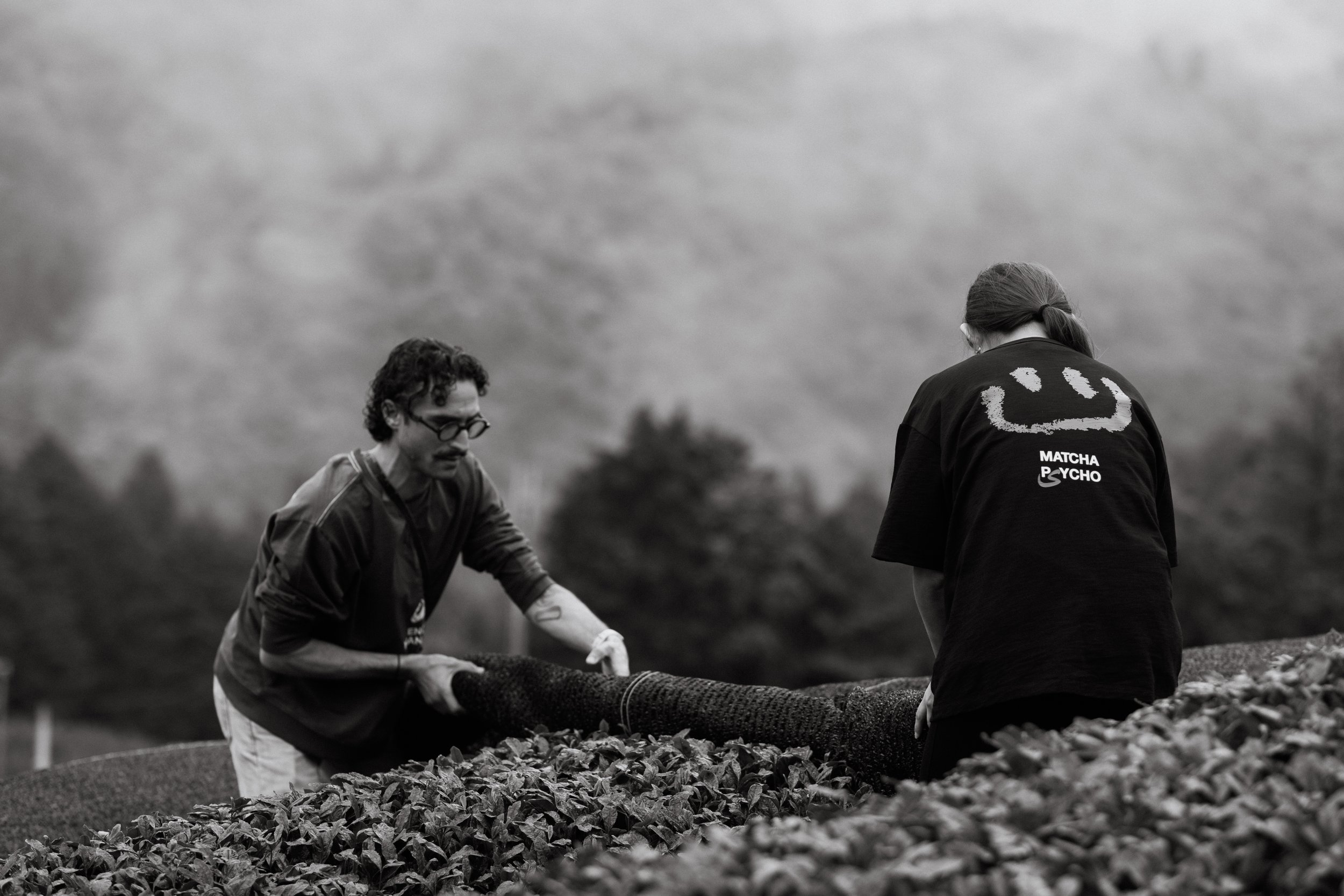





Harvesting tea with a Sentei ki is a three person dance choreographed in situ: two people—positioned on either side of the tea row, each grasping one end of the machine’s arch—together move and maneuver the trimmer, while a third performs the “caboose” roll by keeping the bag aloft and unobstructed as it fills with freshly-cut, back-blown tea material. Whomever occupies the second position at the trimmer (opposite Akky) is guided by a steady stream both of verbal and gestural signs, most of them directional (i.e., up/down, raise/lower, tilt, etc.). Akky has a graceful way of signaling with his free-able hand, as if conducting a symphony orchestra, shaping its sound. (This charming quirk is viewable in the video clip of Sabrina and Akky harvesting together, below the carousel of images).
With each step and forward movement, Akky is judging the optimal depth at which the teeth of the trimmer should come into contact with the tea plants’ tender new shoots. Two factors inform Akky’s determinations of the depth at which to cut new shoots from the plant: firstly, this is a first harvest—one of several in the season—and secondly, it is for tencha that will be ground into a high grade of matcha. As material harvested for making high-grade matcha, Akky wants only to cut the newest “tender, baby” buds the plants have shot up in the preceding weeks, which means ensuring that the trimmer remain above a certain depth. Yet after this first harvest, the plants will be re-shaded to encourage new growth of buds for subsequent harvests, which requires ensuring that this first harvest exposes the leaf sheafs at the joints just below the growth being taken today. It is a delicate balance (which Matsu explains in the second video inlayed below).



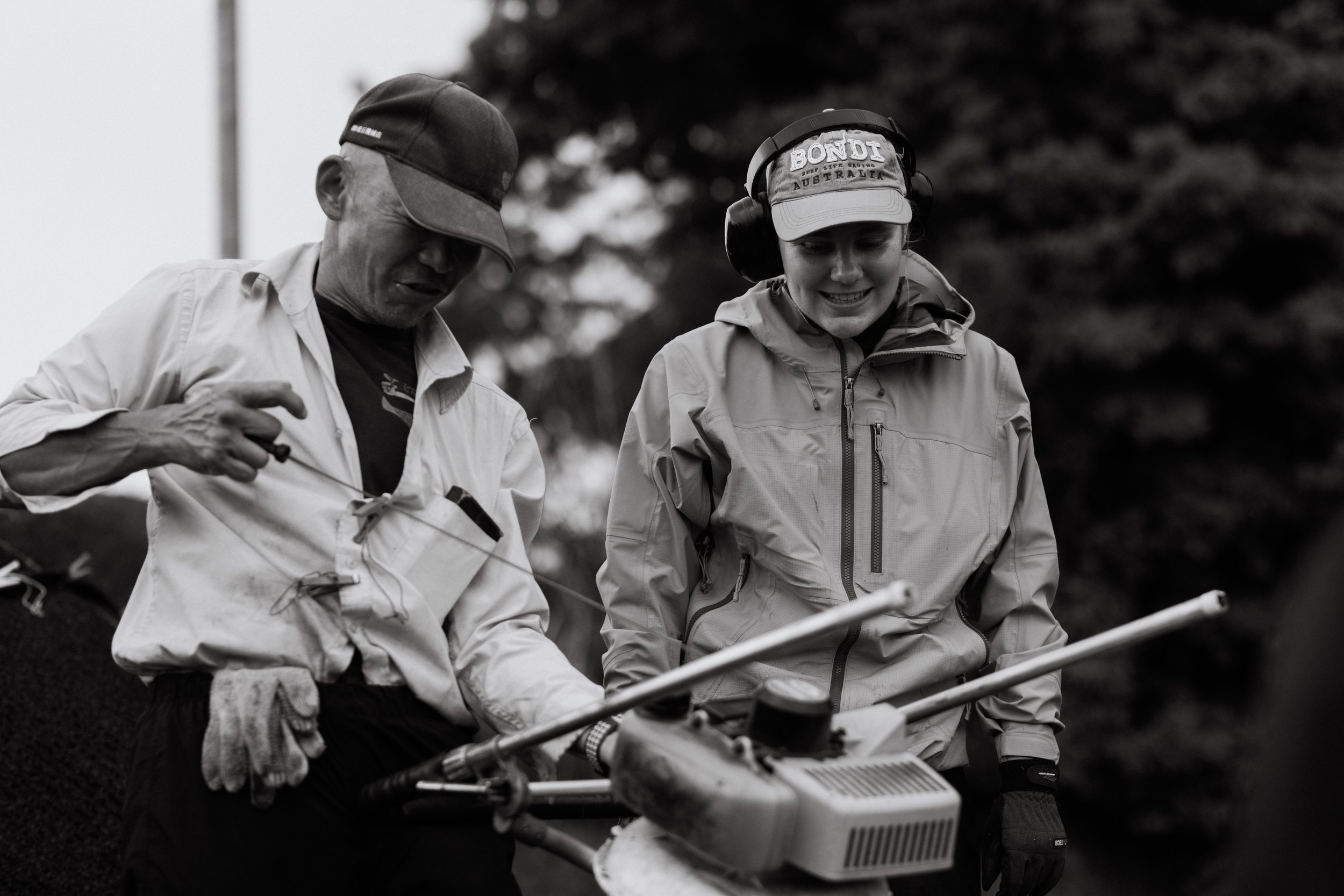

















The harvest is hard work, but encourages moments both of quiet and connection midst the hubbub…
By noon we had harvested all the ready rows in the small plot, which yielded one canvas and mesh bag brimming with tender, first-growth Yabukita buds per row—about 20 total, each weighing anywhere from 8 to 16 kilograms (approx. 17 to 35 pounds). “Let’s get these loaded into the bed of the truck,” Matsu said, “and then we can stop at the tencha processing facility on the way back to Obubu.” One by one we lugged the (immense) tea bags down from their respective row-ends to the truck, where we hauled them up into the bed, cramming one atop the other, until the bed was overflowing with tea bags bursting with just-cut leaves. To secure the load for the mostly off-road trip from the fields to the tencha factory, we tied slipknots with rope and tightened them over the open truck bed. Then Sabrina and I climbed up into the truck and lay prostrate, spreading ourselves and our weight over the tea, tamping it down. “Don’t let go,” Akky warned with a wry smile as he hit the clutch and shifted the truck into first gear. We and our cargo were off.














From the tea field to the tencha factory: human artifice and technical ingenuity at the heart of artisanal agriculture
Soon after descending the mountain and nearing Wazuka town, we arrived at the tencha processing facility: a non-descript barn-like structure, with a single-story A-framed entryway that broadens to an open-aired, manufactory-styled foundry just beyond. A long, elevated driveway leads from the road turnout to the entry, and when farmers who bring their tea to be processed into tencha here arrive from their fields, they back their trucks up the drive until they’ve entered the structure and are then guided by facility workers to a raw material unloading receptacles. When we pull in, the unloading zone is already occupied by another local farm’s truck, so we steer clear and repark at the edge of the road.
Akky and Matsu head up the driveway on foot and straight towards where the other farmers have formed an assembly line for moving their own bags into a bin beside a conveyer belt that will feed the load into an initial steaming apparatus inside the tencha factory. Akky and Matsu greet their counterparts from the neighboring farm—who acknowledge them by perfunctorily greeting them in turn—find places for themselves in the assembly line, and join right in. Assisting their counterparts with the labor of unloading the day’s yield is pragmatic, of course, in that it quickens things along, reducing the wait till our crew can discharge our own materials and get back out to the fields. But from my vantage as a participant-observer, Akky and Matsu’s unspoken yet unhesitating giving of assistance seemed to suggest something more; something beyond mere calculative pragmatism or common impatience. Embedded in this hyper-local form of sociality were displays of collegiality, recognition, community or reciprocal belonging, and perhaps even care.
When the other farmers had finished discharging their morning’s harvest, they thanked us, started up their truck, and drove off. Personnel from the processing facility brought out several brooms, which Matsu and Sabina accepted before beginning to sweep the shop floor clear of tea leaves, stems, and cuttings that had fallen by the wayside. Akky slowly backed the Obubu Tea Farm’s truck up the driveway and into the facility, and then our crew formed an assembly line of our own, one by one seizing and moving the bags of material we’d just harvested from the bed of the truck into a bin for processing. As the contents of the bags were gradually emptied, a mountain of freshly cut tea leaves formed and began to fill the bin. The visual sensation—deep, deep green—was both heightened and eclipsed by its olfactory accompaniments. Earthy. Herbaceous. Vegetal. Minerally. Dank. Alive.
The owner and head of the tencha processing facility emerged from the back of the manufactory as we were finishing up the transfer of material from the truck to the pre-processing receptacles. Acknowledging the rest of us with his eyes, he gestured towards Akky, who removed his cap, wiped sweat from his neck with his shirt tail, replaced his cap, and walked over to chat with the owner, who led him through a door back towards the offices. “He used to be a tea farmer,” Matsu says, referring to the tencha processing facility owner, “and at that time this was a much smaller facility, for what was then his farm’s personal use, not dissimilar from our factory at Obubu.” I wonder why a multigenerational farmer from such a prized region of Japan tea and matcha would elect to give up on farming their own crops for a professional pivot into processing other local farmer’s tencha. When I ask him, Matsu nods knowingly at the question, and answers reservedly: “well, there is more potential upside, more predictability, better hours, no need to worry about succession…”
From a pragmatic point of view, this makes complete sense: business is booming at this local facility, and having mid-day drop-in access to a local facility operated by a fellow agriculturalist from their community is an invaluable service for local farmer’s like Akky from modest, small-scale farms like Obubu. But on the other hand, this isn’t an isolated instance of an ordinary career change but rather an illustration of a broader, complex, and more often than not (to outsiders) invisible phenomenon: that despite the rapidly expanding global market and unprecedented demand for matcha (and ever-increasing commodity prices it fetches for its producers), smaller-scale independent farmers are struggling to adapt to shifting conditions on the ground, as their own and other adjacent industries rapidly reconfigure: maximizing matcha yields, streamlining supply chains, reorienting tea agriculture for export, etc. In that sense, the local tencha processing facility’s owner’s pivot from matcha cultivation to community manufactory operation is as adaptive as it is enterprising. But it is also important that consumers of matcha and tea recognize that the significant shifts to global matcha markets currently underway are ramifying in unexpected ways on the lives and livelihoods of local matcha and tea producers across Japan, even (if not especially for) legacy farmers from storied (i.e., all the more demanded) regions like Uji, including Wazuka.
I have this all in my mind as we follow Akky and the owner back into the bowels of the manufactory. Observing the two of them through the steam, I’m struck by their fraternal manner—a mutual affinity clearly shared despite significant differences in their professional trajectories, which have been shaped by the personal decisions each has made w/r/t how to orient to tea farming as a way of life. (On one hand, a lifelong agriculturalist born into a multi-generational tea farming family in Wazuka, which lands he inherited, erects a tencha processing manufactory on his property and pivots from farming to facility operations; on the other, the son (Akky) of a Zen priest, while attending university in Uji, decides that rather than continuing to learn about tea what he truly desires is to cultivate it, drops out of university, finds part time work on a farm, and arduously but with the utmost care and total conviction, sets about becoming a first generation master tea farmer. And here they are side by side today: two manners of relating to traditions in tea farming; two manners of navigating contemporary reconfigurations to the agricultural professions in Japan (especially independent, craft-scale farmers; and even more especially, producers of matcha)).
The interior of the tencha facility is a sensorial delight. Darkness reigns, but hard light cuts at angles across the high-ceilinged arcades, illuminating billowing clouds of steam tinged with smoke. What are becoming tencha leaves dance as they’re blown about columnar shoots (for controlled moisture reduction) that stretch from the floor to the ceiling. Industrial machines—metallic, rusty, electrical—churn away: indicator lights beep, conveyor belts whirl, pipes tremble as their contents flow, gauges (temperature, time, pressure, etc.) going up and down.
Even at this modest of a scale, the tea processing facility envelops us in the inextricably human and artefactual aspects of agriculture. The english word’s etymology—from the latin for ‘ager’ + ‘cultura,’ literally meaning to culture, grow, or tend to the soil (or fields or territory)—is superficially descriptive, but it obscures agriculture’s unifying underpinnings as a coordinated and unceasing suite of human practices predicated on the manipulation and modification of living matter. Compared with the idyllic, pastoral image of tea fields securely set among breathtaking (and seemingly ancient) natural surrounds—mountainsides, hilltops, rolling valleys cut by clear-flowing streams—here among the steaming, rolling, and drying machines, one isn’t just reminded but truly senses how integral human industry is (and has always been) to agriculture. That culture is the wellspring at the core of agriculture, whether that be of a highly industrialized or an overtly traditional variety. That the first agricultural revolution (the Neolithic one) was the originary industrial and technological revolution: devising techniques for purposefully reshaping living nature (from the organismal to the ecosystemic) radically reshaped—and continues to reshape—human nature (from our biologies to our beliefs). Following the tea we’d harvested from the fields to the factory encourages a recognition of and appreciation for the human artifice and technical ingenuity that enables the cultivation of tea plants as crops; and our recognition of crops as artefacts of as well as conduits for the ongoing, open-ended, potentially artful, and always co-imbricating relationships with living nature that agricultural enduringly affords its human practitioners. The perennial question that places like Wazuka, with their local traditions of practice, remind us to pose is: what form ought agriculture to take—for whom, and where?






